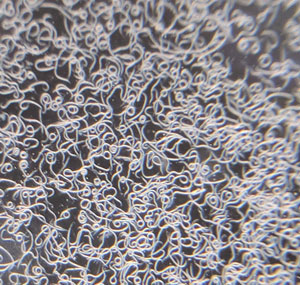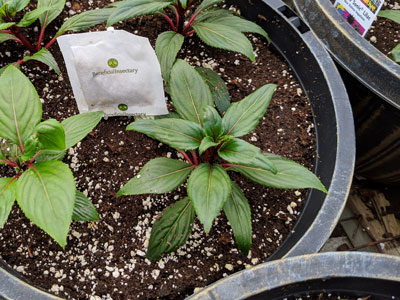4/1/2023
Understanding Biologicals
Jennifer Polanz

I’m starting to see more refrigerators popping up in garden centers I visit across the country, housing biological controls for customers to buy.
It’s not super prevalent, but there’s enough of them that it’s worth talking about, as well as the learning curve behind them. We talk more about biologicals on the other side of the magazine, as growers are beginning to use them more and more as part of a more well-rounded, integrated pest management (IPM) solution. But now those practices are spilling over to retail, either through sachets that are visible in plants coming from growers who use them or through products retailers can sell.
In fact, when I talked with Robert Pye of BioLogic Co., he said every year he hears more and more interest from consumers going to retailers asking about biological controls.
“Before it was word of mouth, us talking to a knowledgeable person at a garden center or trade show and moving the conversation that way,” he said. “Now, people are going to their garden center and asking for it.
“It’s primarily being pushed by consumers.”
The biggest learning curve with biologicals is what the name implies: they are living organisms. That means they have a very definite (and sometimes short) shelf life and need to be handled with specific instructions. Let’s take a look at some options for retail, what you need to know and how to help educate customers about them.
Selling the “Good Bugs”
One option for retail garden centers is beneficial nematodes, Robert said. His company has been a biocontrol supplier since 1985, and actually started primarily selling to retail, which was a much tougher sell back then.
“The biggest challenge to retailers is going to be getting the information to the consumer,” Robert said. “It’s not something that is straightforward like chemicals on a shelf with a big bug on it as the thing you want to kill.”
 Pictured: BioLogic Co. sells beneficial nematodes via its Scanmask Topdressing (pictured), as well as in a spray form. The nematodes are microscopic.
Pictured: BioLogic Co. sells beneficial nematodes via its Scanmask Topdressing (pictured), as well as in a spray form. The nematodes are microscopic.
With beneficial nematodes, they have to be refrigerated at around 38F, plus or minus about 5 degrees. They can keep for up to a year in the refrigerator, so they’re on the longer side for shelf life. They’re microscopic, so they’re not something the consumer is going to see once they open it up. This is where you’re signage is going to come into play.
“The best signage is stressing natural controls for big pests like white grubs, fungus gnats,” Robert said.
And while signage is definitely needed, there’s nothing like in-person education. It also really helps to understand your consumer. These products aren’t necessarily for every retailer, and if you don’t have staff that can explain it, it might not be the right product for you. You also can consider QR codes that link to videos explaining care and applications to give the consumer more details.
Other options are lacewing eggs and ladybugs (although there’s some controversy over live ladybugs as a small percentage of wild-harvested ones could have parasites that may spread to native ladybugs). Both of these also need to be refrigerated and ladybugs only last about two weeks. They’re a fan favorite of customers, though, who aren’t as intimidated by the familiar little spotted bug.
Lacewing eggs can last about a month in the fridge and are generalists in the garden, said Clay Emery of Buchanan’s Native Plants in Texas.
“Because it’s eggs you have to leave them out over the course of a few days for them to hatch before they start eating any insects,” he said. “But the lacewings are definitely easier to put out—you can lay them out at any time of day.”
With either of them, it’s important to know when they went in the refrigerator, and make sure the newest ones are toward the back, with older ones up front to be grabbed first.
Educating Customers
“‘Does it actually work?’ That’s usually the first question we get from people,” Clay said. They’ve produced videos that show how to release beneficials and they recently included an item in their newsletters about it (which is what prompted me to reach out to Buchanan’s for this story).
He also said packaging definitely helps sell the product and the nicer the better when it comes to beneficials.
“I would say packaging is everything,” he noted. “I’ve had to order beneficials from different companies and the prettier the packaging the easier it is to sell an insect to somebody.
“When you break it down they may be a little hesitant and packaging always plays a role in whether they’re going to take your word for it or not.”
 Pictured: It’s getting more common to see plants coming to retail with sachets of beneficial insects in them.
Pictured: It’s getting more common to see plants coming to retail with sachets of beneficial insects in them.
You may receive products from growers, too, that have sachets of beneficial insects in them. It’s important to tell customers what those are and why they’re a good thing, said Casey Decker of Sierra Biological.
“The customers never see most of the bugs we use [as growers] except for the sachets. They are generally on a little stick and look like an unopened tea bag,” Casey said. “The customers will find those in their plants and I get all kinds of weird questions about what those are and are they dangerous.” (Spoiler alert: they’re not.)
“I try to get retailers to proactively put up a sign or a bunch of signs out in the plants on the tables, just explaining we’re using pesticide-free or reduced pesticide IPM programs,” added Casey.
He recently sold his company to Beneficial Insectary (though he’ll continue to lead Sierra as an independent distributor), and Beneficial Insectary has a great explanation about the sachets on their website at insectary.com/sachets.
Encouraging Plantings to Attract Beneficials
Casey said, too, that he’s always happy to come out and give talks at local garden centers about attracting beneficials to consumers’ yards and the right plants to help do that. There are companies that sell beneficials throughout the country, so keep that in mind as you prepare topics for talks throughout the summer.
There are specific plants that help attract beneficials (see our sidebar for a list). The goal is not to be pest-free, but to create an ecosystem where you have plants that will host beneficial insects to prey on the bad bugs.
“Insectary plantings are not necessarily to keep the pests out—you want pests in your garden if you want to attract predators,” Casey said. “There are no lions without gazelles.”
Mother Nature will take care of the rest.
Attracting the Good Bugs
Annuals
Note: Successional sowings of the annual species every two weeks for about six weeks will help prolong bloom period.
• Dill (Anethum graveolens)
• Coriander (Coriandrum sativum)
• Basil (Ocimum basilicum)
• Fennel (Foeniculum vulgare)
• Buckwheat (Fagopyrum esculentum)
• Sweet alyssum (Lobularia maritima)—any white cultivars
• Cornflower (Centaurea cyanus)
• Blanket flower (Gaillardia pulchella)
• Lacey Phacelia (Phacelia tanacetifolia)
• Signet marigold (Tagetes tenuifolia)—single-flowered cultivars such as Lemon Gem
• Plains coreopsis (Coreopsis tinctoria)
• Bush snap bean (Phaseolus vulgaris)—any cultivars
• Eggplant (Solanum melongena) (suggest Japanese-type eggplants as the fruits are smaller, easier to use for cooking and more prolific)
Perennials
Note: The last four provide late-season bloom (when most annuals are setting seed and producing fewer flowers).
• Feverfew (Chrysanthemum parthenium/Tanacetum parthenium)
• Cushion spurge (Euphorbia polychroma/Euphorbia epithymoides)
• Dwarf New England aster (Symphyotrichum novae-angliae e.g. Purple Dome)
• Dwarf goldenrod (Solidago spp. e.g. Little Miss Sunshine, Golden Baby or Golden Fleece).
• Dwarf sneezeweed (Helenium autumnale e.g. Mariachi Sombrero)
• Autumn Joy Stonecrop (Sedum spectabile Autumn Joy)
Biennials
• Caraway (Carum carvi)
Insectary planting suggestions courtesy of Sierra Biological.